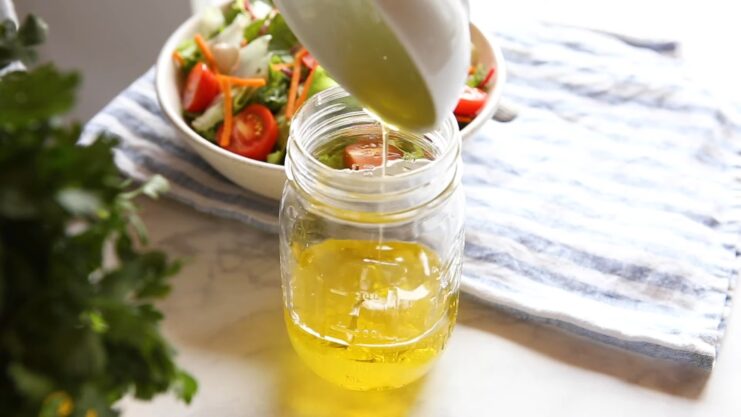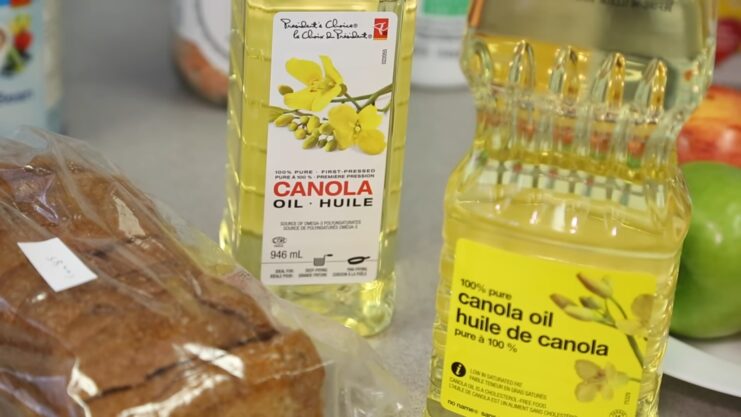The culinary world is a hub of fascinating and flavorful ingredients that have the power to influence the outcome of your dishes remarkably. Among these ingredients, oils play an integral role in cooking, baking, and creating various dishes and desserts. Two widely embraced options are canola and vegetable oils. The former is derived from canola plant seeds, which is a variant of the rapeseed plant, while the latter is an umbrella term for oils extracted from diverse plants, such as soybeans, corn, or sunflower.
In your quest to create the perfect dish or make your recipes healthier, you might find yourself wondering: can you mix canola and vegetable oil? The purpose of this article is to explore this question in-depth, discussing the similarities and differences between the two, and whether mixing them is safe and beneficial.
We will also look at the smoke points, blending ratios, flavor profiles, nutritional benefits, and various applications of these liquid golds. It’s about to get hot in the kitchen, so get ready to dive into the world of culinary oils.
Smoke Point

When it comes to cooking, particularly frying or sautéing, the smoke point is crucial. This term refers to the temperature at which an oil starts to smoke and break down, losing its nutritional value and producing harmful compounds.
Canola and vegetable have different smoke points, 400°F (204°C) and 430-450°F (221-232°C), respectively. These figures suggest that both are suitable for medium to high heat cooking.
When you mix oils with different smoke points, the blend’s overall smoke point tends to skew towards the lower of the two. Thus, a canola-vegetable mix would theoretically have a smoke point closer to that of canola. This understanding helps in determining the heat settings when cooking with mixed oils.
Blending Ratios
If you’ve decided to blend canola and vegetable oils, the next question is: what’s the ideal ratio? The answer largely depends on your purpose. For general cooking, a 1:1 ratio could serve well, capitalizing on both oils’ qualities.
For high heat cooking, a greater proportion of vegetable oil might be beneficial due to its higher smoke point. For example, a 1:2 ratio of canola to vegetable oil could work.
On the other hand, for salad dressings, a higher ratio of canola oil may be preferred due to its higher omega-3 fatty acid content and its slightly nutty flavor, which can enhance the dressing’s taste. For instance, a 2:1 ratio of canola to vegetable oil may be a good starting point.
Flavor Profile
The flavor of oil is a critical consideration in any recipe. Canola is known for its light, slightly nutty flavor. On the other hand, vegetable, particularly if it’s soybean or sunflower-based, is neutral and won’t significantly alter the taste of your dish.
When blended, canola and vegetable can offer a unique balance. The neutrality of the vegetable allows the canola’s slight nuttiness to come forward without overpowering the dish’s other flavors.
This balanced flavor profile can be advantageous in dishes where you want the ingredients’ flavors to shine, but with a touch of complexity added by the canola. However, as flavors can be subjective, feel free to adjust the ratios based on your personal preference.
Nutritional Benefits

Canola is a nutritional powerhouse with an excellent omega-6 to omega-3 ratio, low in saturated fats, and contains a good amount of vitamin E. It’s considered heart-friendly and helps reduce bad cholesterol levels.
Vegetable oil’s nutritional composition depends on the plant source. Most variants, like soybean or sunflower, are high in polyunsaturated fats, particularly omega-6 fatty acids, and also contain a decent amount of vitamin E. However, they usually lack omega-3 fatty acids.
When you blend canola and vegetable, you get a nutritionally balanced mix. The omega-6 from the vegetable, combined with the omega-3 from the canola, can contribute to a healthier diet. Moderation is key when it comes to any fat source, even those deemed healthier. It’s essential to maintain a balanced ratio of these two types of fatty acids for optimum health.
Cooking Applications
Blending canola and vegetable can be particularly advantageous in specific cooking applications. In general cooking, the combined oils work well due to their versatile, neutral flavor profile and relatively high smoke point.
Examples include stir-frying and sautéing, where the blend’s high smoke point allows for quicker, more efficient cooking without degradation. The mild, slightly nutty flavor of the canola also pairs well with a variety of ingredients, enhancing the overall taste of your dishes.
In deep frying, the blended oil can provide a crisp, golden finish to your food, thanks to the high smoke point. The light flavor profile ensures that the taste of the food itself isn’t compromised.
Baking Applications
Oils play an integral role in baking, contributing to the texture, moistness, and shelf-life of baked goods. Canola, due to its light flavor and good fat profile, is a popular choice. It makes the baked goods moist and tender without imparting any strong taste.
Vegetable also performs similarly, keeping baked goods moist and light. However, it’s a bit more neutral in flavor compared to canola.
When combined, these oils can enhance your baking. The blend can lead to moist, light, and flavorful baked goods. However, remember that oil ratios in baking can significantly impact the end product, so it’s best to follow the recipe or make small adjustments to suit your taste.
Salad Dressings and Sauces

In creating salad dressings and sauces, the choice of oil can significantly impact the overall flavor. Canola, with its slightly nutty yet light taste, can add an appealing complexity to your dressings or sauces.
Vegetable, being neutral, allows the other ingredients to shine. This neutrality can be an advantage when creating a sauce or dressing with bold flavors, as the oil won’t overpower them.
When mixed, canola and vegetable can produce a balanced, versatile base for your dressings or sauces. Try this simple vinaigrette recipe: 2 parts canola and vegetable blend, 1 part vinegar, salt, pepper, and your favorite herbs or spices. Shake well, and you’ve got a delicious, homemade vinaigrette!
Storage and Shelf Life

Proper storage of your blended oil can significantly impact its shelf life and quality. Store the mixture in a dark, cool place away from heat and light, which can speed up the degradation process. Also, ensure the container is tightly sealed to prevent exposure to air, which can lead to rancidity.
Blending canola and vegetable does not significantly affect the overall shelf life compared to their individual shelf lives. Both generally have a shelf life of about a year if stored correctly.
For the best quality, use the blend within six months of mixing. If the oil develops a strong, off smell, it may have turned rancid and should be discarded.
Allergies and Sensitivities
While canola and vegetable are generally safe for consumption, it’s essential to consider any allergies or sensitivities. Canola is a derivative of the rapeseed plant. Although the allergenic proteins found in rapeseed are virtually eliminated during oil processing, a small percentage of individuals may still react to it.
Vegetable, depending on its source, can also trigger allergies. Soybean oil, for example, could be problematic for those allergic to soy.
If you have specific dietary needs or allergies, always consult your healthcare provider before introducing new oils or blends into your diet. Alternatives, such as olive oil or avocado oil, may be more suitable for certain individuals.
Conclusion
Can you mix canola oil and vegetable oil? Absolutely! The blending of these two can result in a versatile, balanced, and flavorful option suitable for a variety of cooking and baking applications.
Remember that the key to successful blending lies in understanding each oil’s characteristics – their flavor profiles, smoke points, and nutritional benefits. This understanding allows for optimal ratio adjustments that suit your culinary needs and personal preferences.
So, don’t be afraid to experiment in the kitchen. After all, discovering your preferred combination could just be your next culinary breakthrough!

